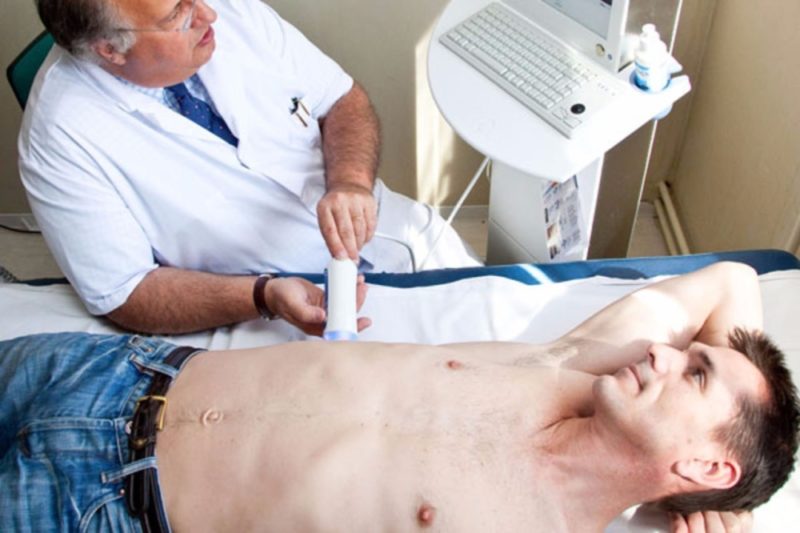Behind this long name “hepatosplenomegaly” is not a specific disease. This is a syndrome that accompanies several pathologies. All of them are quite serious and need to be cured.
Material Content:
What is hepatosplenomegaly?
A burning question: if hepatosplenomegaly is detected in children or adults, what is it, what to expect. The so-called enlargement of the liver and spleen, if this occurs simultaneously. The first is called hepatomegaly, the second - splenomegaly. Doctors combine them into the concept of "hepatolienal syndrome."
The onset of painful changes is sometimes characterized by the large size of one organ: the spleen - with pathologies of the blood, liver - with damage to its tissues. As a result, both organs are involved in the process: they are supplied with blood from a single system
Most often, this pathology occurs in babies in the first 3 years of life. But some diseases provoke it in adults.
Causes of development in an adult and a child
The causes of the syndrome are varied, but hepatosplenomegaly is almost always the result of some kind of ailment or malformation.
In adulthood, these are:
- various liver diseases (90%) - inflammation of any nature, fibrosis, when connective tissue grows between hepatocytes, cysts - the formation of cavities in an organ, tumor;
- heart disease - insufficiency, defects, inflammation of the pericardium;
- infection with infections - brucellosis, mononucleosis, malaria;
- diseases of the circulatory system - leukemia, lymphogranulomatosis, severe anemia, especially malignant;
- parasite infection.
Hepatosplenomegaly in a child is provoked by oncology or intrauterine infection. In newborns, hepatolienal syndrome occurs due to hemolytic disease. Often its cause in older children is an unbalanced, high-fat diet.
Symptoms of manifestation
With isolated hepatosplenomegaly, the patient notes the following symptoms:
- heaviness and bursting under the ribs left or right;
- feeling unwell;
- bitterness in the mouth;
- nausea
- jaundice;
- ascites.
Symptoms of the disease that caused the enlargement of organs join this.
The size of the liver is rapidly growing with oncology and hepatitis caused by viruses. On palpation, the edge of the liver gives severe pain. If a patient is diagnosed with cirrhosis or a blood clot in the splenic vein, the size of the spleen grows faster. With such blood clots, a frequent symptom is bleeding from the intestines or stomach.
On a note! Moderate hepatosplenomegaly is more common than severe.
Diagnostics
Even with full health in people, the edge of the liver is sometimes palpated under the rib. But it has an even structure, acute shape, it is elastic, does not give painful sensations.
With hepatosplenomegaly, the organs are sometimes enlarged so much that it is visible visually. It often happens that organ enlargement is detected during a routine examination. To determine the size of the liver and spleen, their possible deviation from the norm, doctors use palpation (palpation) and percussion (tapping). Percussion helps to easily distinguish between healthy, but lowered abdominal organs and pathologically enlarged ones.
A healthy liver is located along the edge of the costal arch. Palpation allows you to better determine its size. A healthy spleen is more difficult to palpate.
When diagnosing with palpation, it is necessary to distinguish a liver, increased in size, from other pathologies:
- tumors in nearby organs - this is the colon, kidney or gall bladder;
- hepatoptosis due to emphysema, pleurisy, or a subphrenic abscess.
An enlarged spleen during palpation can be confused with a tumor in the kidney or pancreas, or a cyst in it.
But just diagnosing hepatolienal syndrome is not enough, you need to identify the causes that caused it.
This will require consultation with a gastroenterologist and a series of tests and studies:
- a general blood test in which hypersplenism can be detected - a decrease in the number of platelets, white blood cells and red blood cells, and this is a reliable sign of hepatosplenomegaly;
- increased indicators of “liver tests” in biochemical analysis indicate damage to hepatocytes or cardiac pathology;
- Ultrasound, and, if necessary, CT of the abdominal organs allows not only to determine how enlarged the liver and spleen are, but also to identify the painful state of other organs.
In doubtful cases, a liver puncture is performed and the punctate obtained is examined.
How to treat a disease
When isolated hepatosplenomegaly is detected, but there are no symptoms of the underlying disease that caused it, the patient is undergoing passive monitoring for the first 3 months. If there is no improvement, hospitalization and in-depth examination are required.
Therapy of hepatolienal syndrome is carried out comprehensively:
- eliminate its cause;
- improve the condition of the spleen and liver involved in the pathological process.
The main disease is treated according to the scheme adopted in each case.
To improve the condition of the liver and spleen when detecting a viral infection, detoxification therapy is used in addition to the following drugs:
- choleretic - for better evacuation of bile;
- antispasmodics - to relieve spasms and reduce pain;
- hepatoprotectors - restore hepatocytes and improve liver function;
- anti-inflammatory drugs.
When treating children, it is taken into account that the hepatolienal syndrome in them sometimes disappears on their own when the cause that caused it disappears. For the rest, the same drugs are prescribed as for adults, but in dosages appropriate for age.
Diet for liver disease
Damaged liver tissue is not able to produce enough bile; this affects digestion. A sparing diet will help the digestive tract to function properly.
What products are recommended:
- preference is given to sour-milk products with low fat content, fresh milk can be added to the dish when cooking in a small amount;
- fish and meat - lean, boiled or baked;
- for cereals choose cereals from whole grains;
- vegetarian soups on vegetable broth;
- fresh, baked and boiled vegetables that do not contain liver irritating substances - pumpkin, zucchini, carrots;
- unsweetened fruit jelly, jelly, baked apples;
- fruits that do not contain large amounts of acids.
From the diet exclude everything that contains spices and extractives, dyes and preservatives.
You can’t fry anything.
The consequences of hepatosplenomegaly
If the disease that caused the hepatolienal syndrome is detected, its consequences depend on the complete cure of the disease. After this, the organs can return to their original state, but this does not always happen. If changes in them are irreversible, the development of functional insufficiency of the liver or spleen is possible.
Forecast and Prevention
The prognosis directly depends on the cause of the condition. The development of hepatosplenomegaly depends on many factors and occurs individually in each case. But common is the need for compulsory treatment.
Revealed hepatosplenomegaly is an occasion to seek medical help and fulfill all the doctor's recommendations.



















